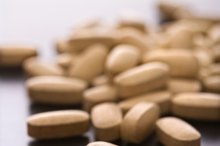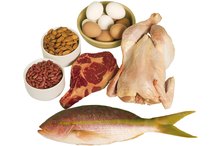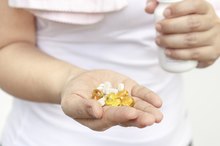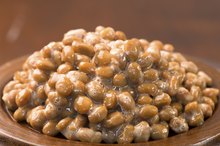Vitamin D2 Deficiency Symptoms
Vitamin D refers to two different forms of this vitamin: vitamin D-2 and vitamin D-3. Vitamin D-3 is synthesized when skin absorbs sunlight, while vitamin D-2 is made by plants. Your body converts both forms into the same hormone, so they fill the same roles and they are referred to collectively as vitamin D. Since the primary role of vitamin D is to enable calcium absorption, signs of a deficiency often appear in your bones.
Bone And Muscle Weakness
If you lack an adequate amount of vitamin D, your body can't absorb enough calcium. This has a double impact on your bones. For starters, you won't have enough calcium to maintain healthy bones. But calcium has other vital jobs to fill, such as maintaining muscle contractions in your heart. When calcium is low, your body takes it away from your bones to fill its other roles. As a result, vitamin D deficiency causes a loss of bone density, which leads to bone pain, weak bones and an increased risk for osteoporosis. Muscle weakness and aches may also indicate a vitamin D deficiency since vitamin D may help maintain muscle strength.
- If you lack an adequate amount of vitamin D, your body can't absorb enough calcium.
- But calcium has other vital jobs to fill, such as maintaining muscle contractions in your heart.
Lowered Immune Response
Does Vitamin B12 Make You Lose Weight?
Learn More
Vitamin D plays an important role in maintaining an adequate immune response in the body. It regulates proteins that kill bacteria and stimulates the growth of white blood cells that destroy invading pathogens. A vitamin-D weakened immune system is associated with an increased risk of flu. Inadequate vitamin D is also involved with serious autoimmune disorders such as arthritis, multiple sclerosis and Type 1 diabetes, according to the Linus Pauling Institute.
- Vitamin D plays an important role in maintaining an adequate immune response in the body.
- Inadequate vitamin D is also involved with serious autoimmune disorders such as arthritis, multiple sclerosis and Type 1 diabetes, according to the Linus Pauling Institute.
Depression And Cognitive Problems
According to Women To Women, depression and mood swings may be symptoms of vitamin D deficiency. Chronic fatigue is a common byproduct of low vitamin D and this may contribute to irritability or a low mood in people. Older people may experience disorganized thought patterns and have difficulty with concentration or memory. These cognitive challenges may indicate low vitamin D2 levels. Adequate vitamin D may help stabilize energy, mood and cognition to healthy levels.
- According to Women To Women, depression and mood swings may be symptoms of vitamin D deficiency.
Sources and Recommendations
Vitamin K Foods to Avoid While on Coumadin
Learn More
Mushrooms are the primary source of vitamin D-2. They contain a substance -- ergosterol -- that turns into vitamin D-2 when exposed to sunlight. The amount of vitamin D-2 varies significantly from one mushroom to the next, but some producers purposefully expose mushrooms to ultraviolet light to boost their D-2 levels. Vitamin D-2 is also synthetically produced for use in supplements. In any form, vitamin D does not naturally occur in most foods. Fatty fish, such as salmon and mackerel, contain vitamin D-3. Otherwise, most people get vitamin D from fortified milk and other foods. You should consume 600 international units, or 15 micrograms, of vitamin D daily.
- Mushrooms are the primary source of vitamin D-2.
- Fatty fish, such as salmon and mackerel, contain vitamin D-3.
Related Articles
References
- Linus Pauling Institute: Vitamin D
- Women To Women: Is Vitamin D Deficiency Casting A Cloud Over Your Health?
- Journal of Pharmacology and Pharmacotherapeutics: Vitamin D: The Sunshine Vitamin
- Office of Dietary Supplements: Vitamin D
- Linus Pauling Institute: Nutrition and Immunity
- Holick MF, Gordon CM. Patient Guide to Vitamin D Deficiency. The Journal of Clinical Endocrinology & Metabolism. 2011;96(7):1-2. doi:10.1210/jcem.96.7.zeg33a
- Sunyecz JA. The use of calcium and vitamin D in the management of osteoporosis. Ther Clin Risk Manag. 2008;4(4):827-836. doi:10.2147/tcrm.s3552
- Giovannucci E, Liu Y, Hollis BW, Rimm EB. 25-hydroxyvitamin D and risk of myocardial infarction in men: a prospective study. Arch Intern Med. 2008;168(11):1174-1180. doi:10.1001/archinte.168.11.1174
- Gorham ED, Garland CF, Garland FC, et al. Optimal vitamin D status for colorectal cancer prevention: a quantitative meta analysis. Am J Prev Med. 2007;32(3):210-216. doi:10.1016/j.amepre.2006.11.004
- Lappe JM, Travers-Gustafson D, Davies KM, Recker RR, Heaney RP. Vitamin D and calcium supplementation reduces cancer risk: results of a randomized trial. The American Journal of Clinical Nutrition. 2007;85(6):1586-1591. doi:10.1093/ajcn/85.6.1586
- Prentice RL, Pettinger MB, Jackson RD, et al. Health risks and benefits from calcium and vitamin D supplementation: Women’s Health Initiative clinical trial and cohort study. Osteoporos Int. 2013;24(2):567-580. doi:10.1007/s00198-012-2224-2
- Urashima M, Segawa T, Okazaki M, Kurihara M, Wada Y, Ida H. Randomized trial of vitamin D supplementation to prevent seasonal influenza A in schoolchildren. Am J Clin Nutr. 2010;91(5):1255-1260. doi:10.3945/ajcn.2009.29094
- Salehpour A, Hosseinpanah F, Shidfar F, et al. A 12-week double-blind randomized clinical trial of vitamin D₃ supplementation on body fat mass in healthy overweight and obese women. Nutr J. 2012;11:78. doi:10.1186/1475-2891-11-78
- Carrillo AE, Flynn MG, Pinkston C, et al. Impact of vitamin D supplementation during a resistance training intervention on body composition, muscle function, and glucose tolerance in overweight and obese adults. Clin Nutr. 2013;32(3):375-381. doi:10.1016/j.clnu.2012.08.014
- Marcinowska-Suchowierska E, Kupisz-Urbańska M, Łukaszkiewicz J, Płudowski P, Jones G. Vitamin D Toxicity-A Clinical Perspective. Front Endocrinol. 2018;9:550. doi:10.3389/fendo.2018.00550
- Ross AC, Manson JE, Abrams SA, et al. The 2011 report on dietary reference intakes for calcium and vitamin D from the Institute of Medicine: what clinicians need to know. J Clin Endocrinol Metab. 2011;96(1):53-58. doi:10.1210/jc.2010-2704
- Bouillon R, Van Schoor NM, Gielen E, et al. Optimal vitamin D status: a critical analysis on the basis of evidence-based medicine. J Clin Endocrinol Metab. 2013;98(8):E1283-E1304. doi:10.1210/jc.2013-1195
- American Academy of Dermatology. Position Statement of Vitamin D. 2010.
- Taksler GB, Cutler DM, Giovannucci E, Keating NL. Vitamin D deficiency in minority populations. Public Health Nutr. 2015;18(3):379-391. doi:10.1017/S1368980014000457
- Holick MF, Binkley NC, Bischoff-Ferrari HA, et al. Evaluation, treatment, and prevention of vitamin D deficiency: an Endocrine Society clinical practice guideline. J Clin Endocrinol Metab. 2011;96(7):1911-1930. doi:10.1210/jc.2011-0385
- Cannell JJ, Vieth R, Umhau JC, et al. Epidemic Influenza and Vitamin D. Epidemiol Infect. 2006; 134:1129-40.
- Carrillo AE1, Flynn MG, Pinkston C, Markofski MM, Jiang Y, Donkin SS, Teegarden D. Impact of Vitamin D Supplementation During a Resistance Training Intervention on Body Composition, Muscle Function, and Glucose Tolerance in Overweight and Obese Adults. Clin Nutr. 2013 Jun;32(3):375-81. doi: 10.1016/j.clnu.2012.08.014. Epub 2012 Aug 31.
- Ginde AA, Mansbach JM, Camargo CA, Jr. Association Between Serum 25-Hydroxyvitamin D Level and Upper Respiratory Tract Infection in the Third National Health and Nutrition Examination Survey. Arch Intern Med. 2009; 169:384-90.
- Giovannucci E, Liu Y, Hollis BW, Rimm EB. 25-hydroxyvitamin D and Risk of Myocardial Infarction in Men: a Prospective Study. Arch Intern Med. 2008; 168:1174-80.
- Gorham ED, Garland CF, Garland FC, Grant WB, Mohr SB, Lipkin M, Newmark HL, Giovannucci E, Wei M, Holick MF. Optimal Vitamin D Status for Colorectal Cancer Prevention: a Quantitative Meta-analysis. Am J Prev Med. 2007 Mar;32(3):210-6.
- Heaney, Robert P. “The Vitamin D Requirement in Health and Disease.” The Journal of Steroid Biochemistry & Molecular Biology 97 (2005):13-9.
- Holick MF. Vitamin D. In: Shils M, Olson J, Shike M, Ross AC, ed. Modern Nutrition in Health and Disease, 9th ed. Baltimore: Williams and Wilkins, 1999.
- National Institutes of Health Office of Dietary Supplements. Vitamin D: Dietary Supplement Fact Sheet. University of Ottawa Evidence-based Practice Center. Effectiveness and Safety of Vitamin D in Relation to Bone Health. Agency for Healthcare Research and Quality. Aug 2007: 07-E013.
- Salehpour A1, Hosseinpanah F, Shidfar F, Vafa M, Razaghi M, Dehghani S, Hoshiarrad A, Gohari M. A 12-week Double-blind Randomized Clinical Trial of Vitamin D₃ Supplementation on Body Fat Mass in Healthy Overweight and Obese Women. Nutr J. 2012 Sep 22;11:78. doi: 10.1186/1475-2891-11-78.
- Urashima M, Segawa T, Okazaki M, Kurihara M, Wada Y, Ida H. Randomized Trial of Vitamin D Supplementation to Prevent Seasonal Influenza A in Schoolchildren. Am J Clin Nutr. 2010 91:1255-60. Epub 2010 Mar 10.
- Wilkins, Consuelo H. and Yvette I. Sheline, et al. “Vitamin D Deficiency Is Associated with Low Mood and Worse Cognitive Performance in Older Adults.” American Journal of Geriatric Psychiatry 14 (2006): 1032-40.
Writer Bio
Jill Andrews began writing professionally for various online publications since 2009. Andrews holds a Bachelor of Science in biochemistry/nutrition from Memorial University in St.John's, Newfoundland. She also holds a Bachelor of Science in occupational therapy from Dalhousie University in Halifax, Nova Scotia.









